
I want to introduce you to the world of comforting flavors and soul-warming aromas! Classic Homemade Chili is a tasty dish that has stood the test of time in our family. Whenever I’m craving something warm that provides immediate comfort, I make this dish. Without a doubt, this recipe is bursting with savory spices, tender meat, and tasty beans. This timeless recipe is a true culinary masterpiece, especially in my family.

Why do people love chili?
Chili is a comfort food that fills you up and leaves you feeling satisfied. Its combination of meat, beans, and spices creates a hearty meal, making it perfect for chilly days or cozy evenings.
My friend Harry from Texas, whom most of us know from our comment forum, told me years ago that no one in Texas makes chili with beans. I still think of this every time I make chili. It makes me giggle every time because I grew up with chili being made with more beans than meat. Harry would be so proud of me today with the meat-to-bean ratio! LOL! Good friends are hard to find! Thanks, my friend, for teaching me the Texan way to make REAL chili.
Items You May Need In The Kitchen
- 6 or 7 Quart Slow Cooker or 8 Quart Soup Pot
- Good Knife To Chop Vegetables
- Measuring Cups
- Measuring Spoons
- Soup Ladle
- Scratch-Resistant Cutting Boards
Ingredients
- Ground Beef: Ground beef is the base of this chili recipe and is an excellent source of protein.
- Onions: Onions add flavor and texture to the recipe.
- Garlic: A powerhouse of flavor that adds to any chili.
- Diced Tomatoes: They are great when simmering a chili or soup because they stay firm.
- Tomato Sauce: It brings a blend of tomatoes with spices when added to chili.
- Red Bell Pepper: They add color, little to no odor, and a bit of sweetness to the recipe.
- Celery: It adds essential flavor and a bit of crunch to this chili.
- Kidney Beans (rinse and drain): They are a great source of iron, phosphorus, and potassium and a low-fat protein source.
- Chili Beans: Canned chili beans are seasoned with a liquid mixture that adds more flavor to the chili.
- Spices: Various spices listed below add flavor to the chili recipe.
Instructions
Step One: Gather The Ingredients
The first step is to gather all of the ingredients. I like to have everything ready to go so I don’t have to waste time searching for what I need.

Step Two: Brown the Ground Beef, Onions, and Garlic
Brown the ground beef with chopped onions and minced garlic. This speeds up the overall cooking time, since you want the meat fully cooked before you’re done.
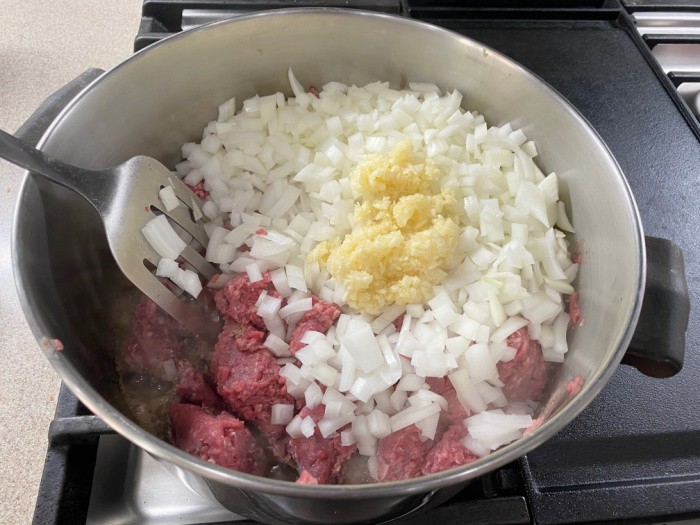
Step Three: Cook Until You Do Not See Any Pink Color
Cook until you don’t see any remaining pink in the meat, for safety and texture.
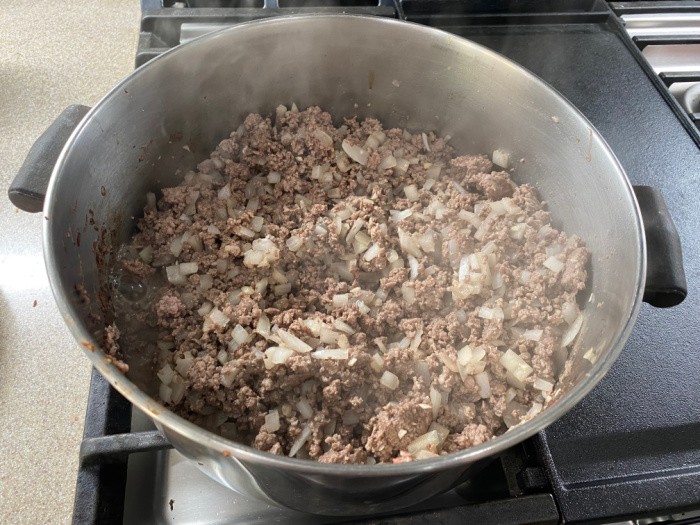
Step Four: Add The Celery
Add the chopped celery to the cooked meat mixture.

Step Five: Add The Red Bell Pepper
Add the chopped red bell pepper to the meat mixture.

Step Six: Measure The Spices/Seasonings
Measure all the spices/seasonings into a bowl.
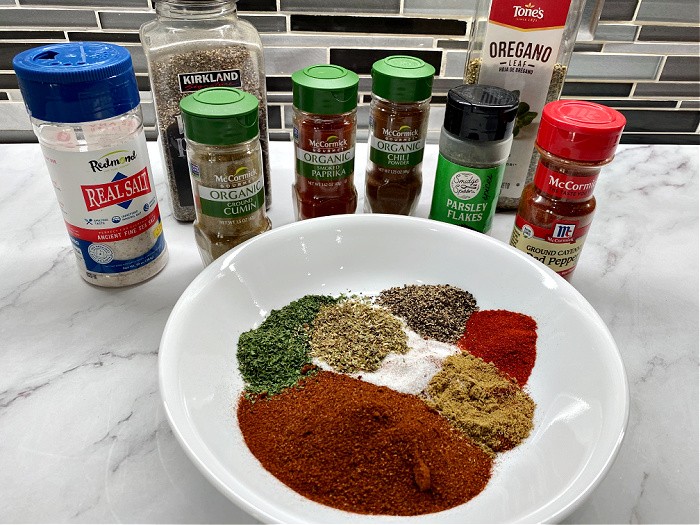
Step Seven: Sprinkle The Spices Over The Meat Mixture
Sprinkle the spice/seasoning mixture over the meat mixture and stir until thoroughly combined.
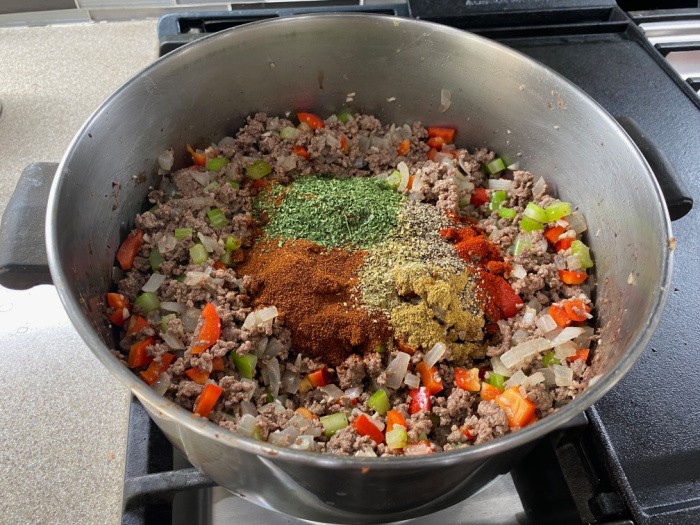
Step Eight: Add The Beans, Tomatoes, and Tomato Sauce
Place the cooked meat mixture in the slow cooker and add the beans, tomatoes, and tomato sauce.
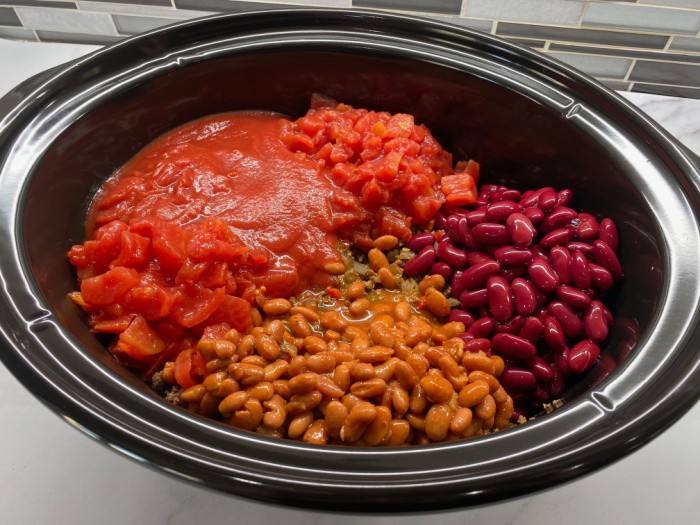
Step Nine: Cook on Low for 7-8 Hours or 4 Hours on High
During this step, you will cook on low for 7-8 hours or on high for 4 hours.

Finished Product
All you need to do is enjoy the chili when you’re done! You can add toppings to the chili, or you can enjoy it as is.

Classic Homemade Chili Recipe

Classic Homemade Chili Recipe
Ingredients
- 3 pounds lean ground beef
- 2 medium chopped onions
- 4-5 cloves of garlic, minced
- 3 stalks of celery, finely chopped
- 3 14-ounce cans of diced tomatoes (do not drain)
- 1 14-15 ounce can of tomato sauce
- 1 15-ounce can of kidney beans, rinse and drain
- 1 15-ounce can of chili beans, do not drain
Chili Seasoning Mix
- 4 tablespoons Chili powder
- 1 tablespoon Cumin
- 2 teaspoons Parsley
- 1/2 teaspoon Cayenne pepper
- 1 teaspoon Smoked Paprika
- 1 teaspoon Salt
- 1 teaspoon Pepper
- 1 teaspoon Oregano
Instructions
-
Gather the ingredients.
-
Brown the ground beef with chopped onions and minced garlic.
-
Cook until you do not see any remaining pink color.
-
Add the chopped celery to the meat mixture.
-
Add the chopped red bell pepper to the meat mixture.
-
Measure all the spices/seasonings into a bowl.
-
Sprinkle the spice/seasoning mixture over the meat mixture and stir until thoroughly combined.
-
Add the cooked meat mixture to the slow cooker and add the beans, tomatoes, and tomato sauce.
-
Place the lid on the slow cooker and cook on HIGH for 4 hours or on LOW for 7-8 hours.
Can I make vegetarian chili?
Yes, you can definitely make a vegetarian version of classic homemade chili. Omit the ground meat and replace it with additional beans or other plant-based protein sources such as lentils or tofu. The rest of the ingredients and cooking process remain the same.
Can I freeze homemade chili?
Absolutely! Homemade chili freezes very well, making it a convenient option for meal prep or for storing leftovers. Allow the chili to cool completely, then transfer it to airtight containers or freezer bags and label them with the date. It can be stored in the freezer for up to 3 months. To reheat, thaw the chili in the refrigerator overnight, then warm it on the stove or in the microwave.
What are some standard toppings for classic homemade chili?
Popular toppings for classic homemade chili include shredded cheese (cheddar cheese is a popular choice), diced onions, sour cream, chopped fresh cilantro, sliced jalapeños, and crushed tortilla chips. These toppings add extra flavor and texture to the chili. Some people will actually add sliced avocado to their individual bowls of this chili.
An authentic favorite side dish is some fresh cornbread along with the chili. It also makes you feel fuller and more satisfied while adding more fiber to the meal. We also like to smother some baked potatoes with the chili for a unique flavor and texture rather than eating it plain.
If you like a more liquid approach, consider adding some beef broth. If you like it a little thicker, try adding some tomato paste during cooking. It won’t affect the taste, but it will slightly change the texture.
Can I adjust the spice level of homemade chili?
Yes, you can easily adjust the spice level of homemade chili to suit your taste. If you prefer a milder chili, reduce the chili powder or use a milder variety. If you like it spicier, add more chili powder or incorporate hotter chili pepper varieties such as cayenne or chipotle. You can also add your favorite hot sauce as a regular ingredient or keep it available on the side for individuals to add as they request.
What is traditional chili made of?
Traditional chili is made of a combination of key ingredients that come together to create a distinctive flavor and hearty texture. Ground beef is the foundation of conventional chili. Most people also add kidney beans, which add extra protein to the chili.
A fun adjustment to “traditional” chili is to use ground turkey instead of beef. A variety of beans can be substituted, such as pinto and black beans, along with mushrooms and veggies like carrots and green onions.
Diced tomatoes are often added to provide a flavorful base. You’ll also find that traditional chili uses chili powder, a blend of spices like cumin, garlic powder, onion powder, and paprika.
Can I cook this chili in something other than a slow cooker?
I’ve used my large Dutch oven to cook chili, and it works fine. You need to adjust the temperature and cooking time as suggested in the manufacturer’s cookbook. You may want to try using a pressure cooker like an Instant Pot, but I’m concerned the veggies added may end up too soft and mushy.
Where Was The First Chili Ever Made?
The origins of chili, often called chili con carne, trace back to the American Southwest, most likely San Antonio, Texas, in the early 1700s to 1800s.
Here’s a quick breakdown of its roots:
- Early Inspiration: The dish likely evolved from Mexican and Spanish cooking traditions, combining indigenous ingredients (like chili peppers) with European meats and spices.
- “Chili con carne” literally means chili with meat. Early versions were made by Tex-Mex settlers and cowboys, using dried beef, fat, chili peppers, and salt, a hearty meal that kept well on the trail.
- San Antonio’s Claim to Fame: By the 1800s, Chili Queens in San Antonio were selling bowls of chili in the city’s plazas, making it the birthplace of what we now know as Texas chili.
- Fun Fact: Traditional Texas chili doesn’t include beans or tomatoes, just meat and chiles.
More Recipes
- 3 Bean Chili Soup Mix In A Jar
- Homemade Vegetarian Chili
- Friendship Soup Mix In A Jar
- Why And How We All Need To Store Lots Of Beans
Final Word
When it comes to making Classic Homemade Chili, this is the best chili recipe to make! Whether you call it a classic chili recipe, a beef chili recipe, or a slow cooker chile recipe, it’s always a winner in our home, and my kids and grandkids love it. It’s also a recipe that can be topped if you’d like. Whether you want to add sour cream, cheese, or sprinkle extra seasonings, this is the perfect easy chili recipe for you to enjoy with your family this fall. May God Bless this World, Linda
The post Classic Homemade Chili Recipe appeared first on Food Storage Moms.
from Food Storage Moms





